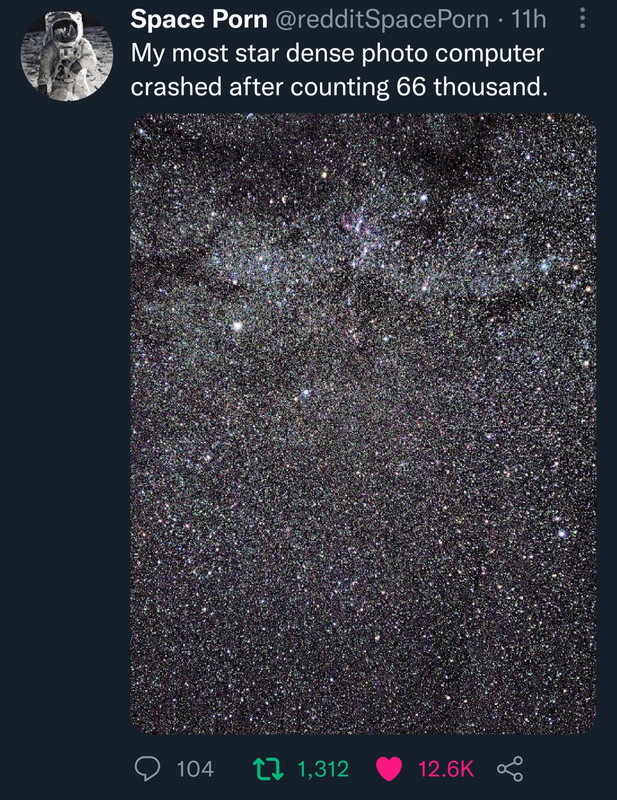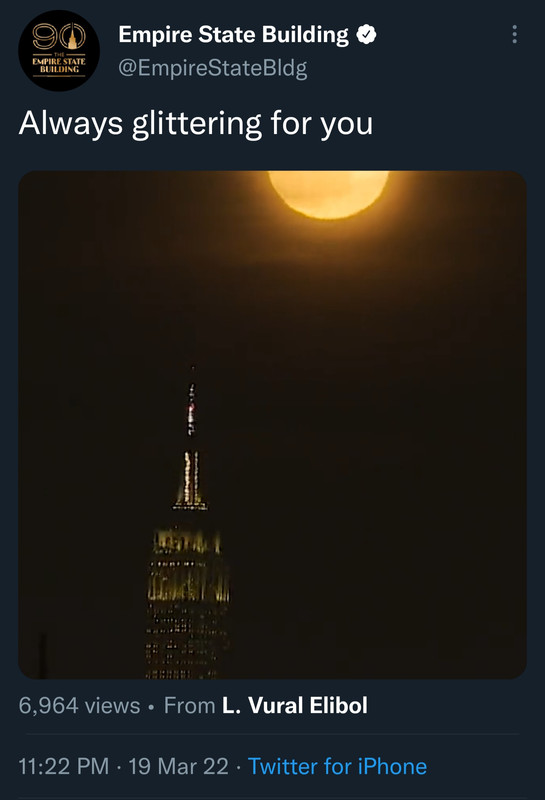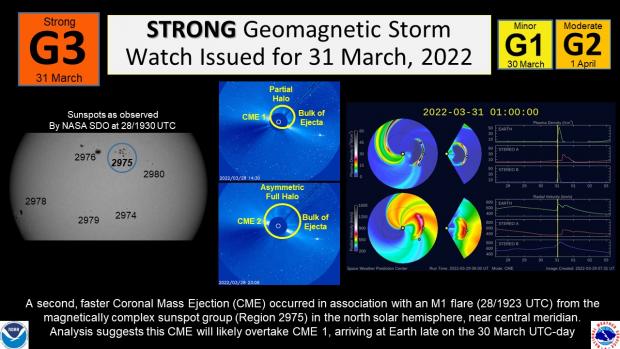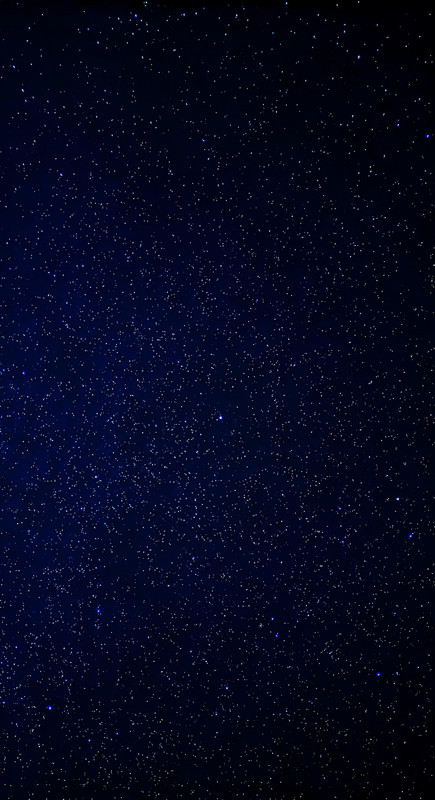-
SCAM WARNING! See how this scam works in Classifieds.
You are using an out of date browser. It may not display this or other websites correctly.
You should upgrade or use an alternative browser.
You should upgrade or use an alternative browser.
I just saw the moon
- Thread starter TheMadDabber
- Start date
CrazyDiamond
HAL is a StarChild
From JWST...
While the purpose of this image was to focus on the bright star at the center for alignment evaluation, Webb's optics and NIRCam are so sensitive that the galaxies and stars seen in the background show up. At this stage of Webb’s mirror alignment, known as “fine phasing,” each of the primary mirror segments have been adjusted to produce one unified image of the same star using only the NIRCam instrument. This image of the star, which is called 2MASS J17554042+6551277, uses a red filter to optimize visual contrast.
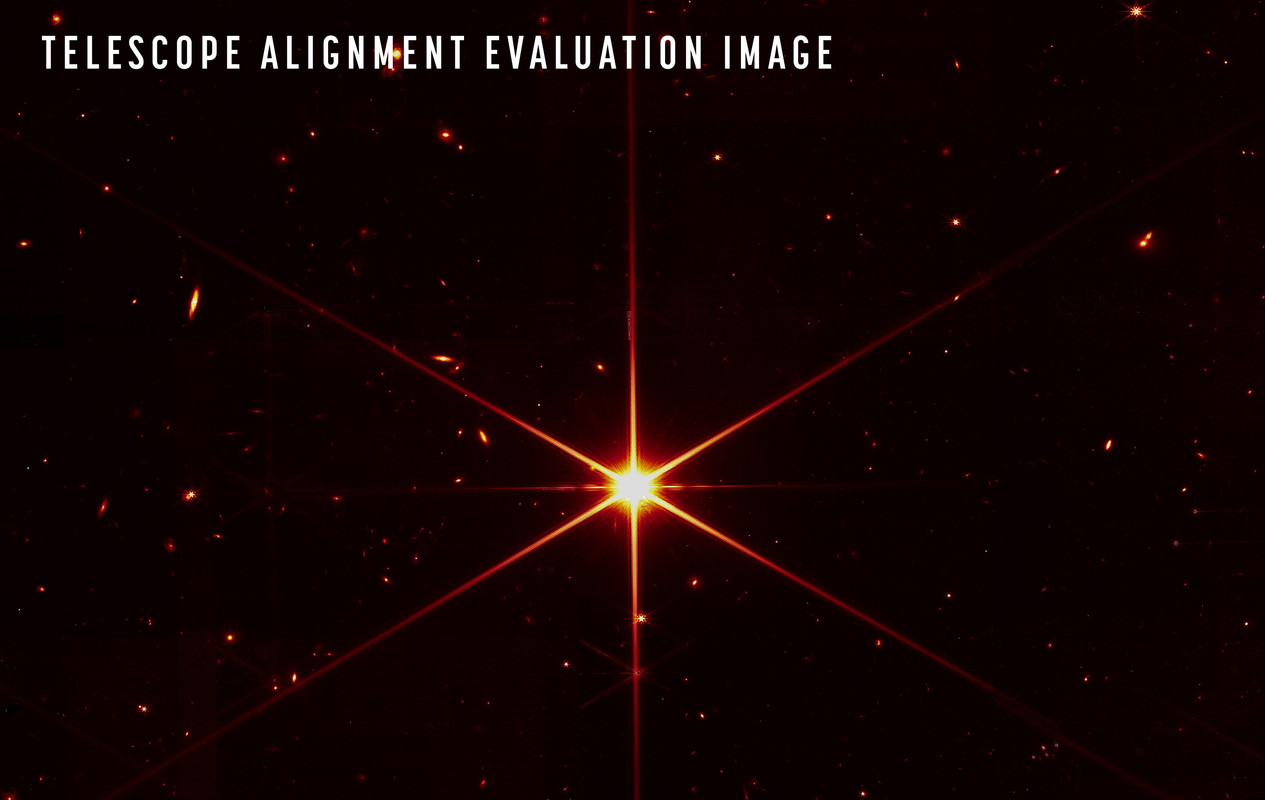
Full Article
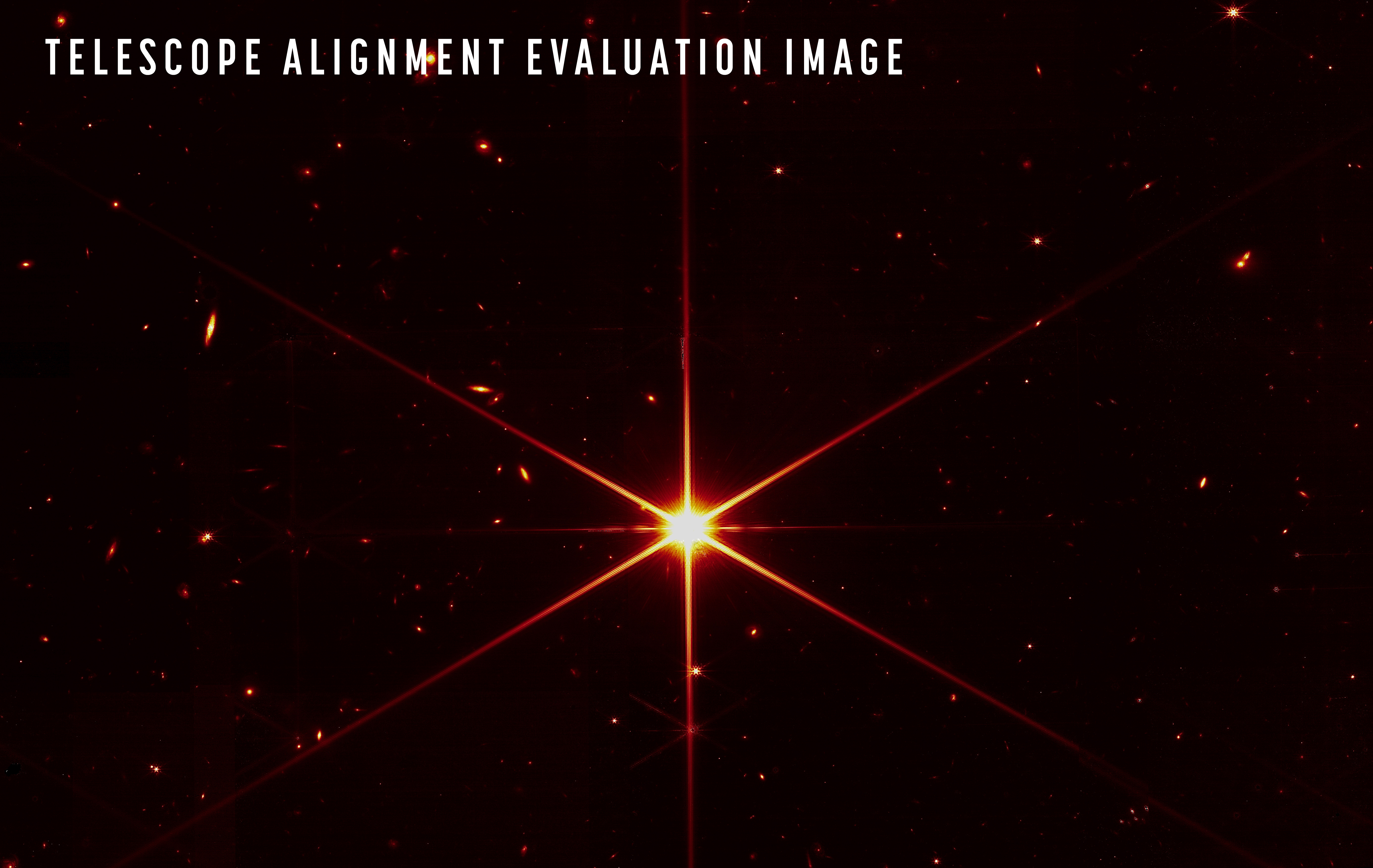
 www.nasa.gov
www.nasa.gov
While the purpose of this image was to focus on the bright star at the center for alignment evaluation, Webb's optics and NIRCam are so sensitive that the galaxies and stars seen in the background show up. At this stage of Webb’s mirror alignment, known as “fine phasing,” each of the primary mirror segments have been adjusted to produce one unified image of the same star using only the NIRCam instrument. This image of the star, which is called 2MASS J17554042+6551277, uses a red filter to optimize visual contrast.

Full Article

NASA’s Webb Reaches Alignment Milestone, Optics Working Successfully - NASA
Lee esta nota de prensa en español aquí.
CrazyDiamond
HAL is a StarChild
What's happened to our Sun? Last month, it produced the largest prominence ever imaged together with a complete solar disk. The record image, featured, was captured in ultraviolet light by the Sun-orbiting Solar Orbiter spacecraft. A quiescent solar prominence is a cloud of hot gas held above the Sun's surface by the Sun's magnetic field. This solar prominence was huge -- spanning a length rivaling the diameter of the Sun itself. Solar prominences may erupt unpredictably and expel hot gas into the Solar System via a Coronal Mass Ejection (CME). When a CME strikes the Earth and its magnetosphere, bright auroras may occur. This prominence did produce a CME, but it was directed well away from the Earth. Although surely related to the Sun's changing magnetic field, the energy mechanism that creates and sustains a solar prominence remains a topic of research.

This was a very unusual type of solar eclipse. Typically, it is the Earth's Moon that eclipses the Sun. In 2012, though, the planet Venus took a turn. Like a solar eclipse by the Moon, the phase of Venus became a continually thinner crescent as Venus became increasingly better aligned with the Sun. Eventually the alignment became perfect and the phase of Venus dropped to zero. The dark spot of Venus crossed our parent star. The situation could technically be labeled a Venusian annular eclipse with an extraordinarily large ring of fire. Pictured here during the occultation, the Sun was imaged in three colors of ultraviolet light by the Earth-orbiting Solar Dynamics Observatory, with the dark region toward the right corresponding to a coronal hole. Hours later, as Venus continued in its orbit, a slight crescent phase appeared again. The next Venusian transit across the Sun will occur in 2117.
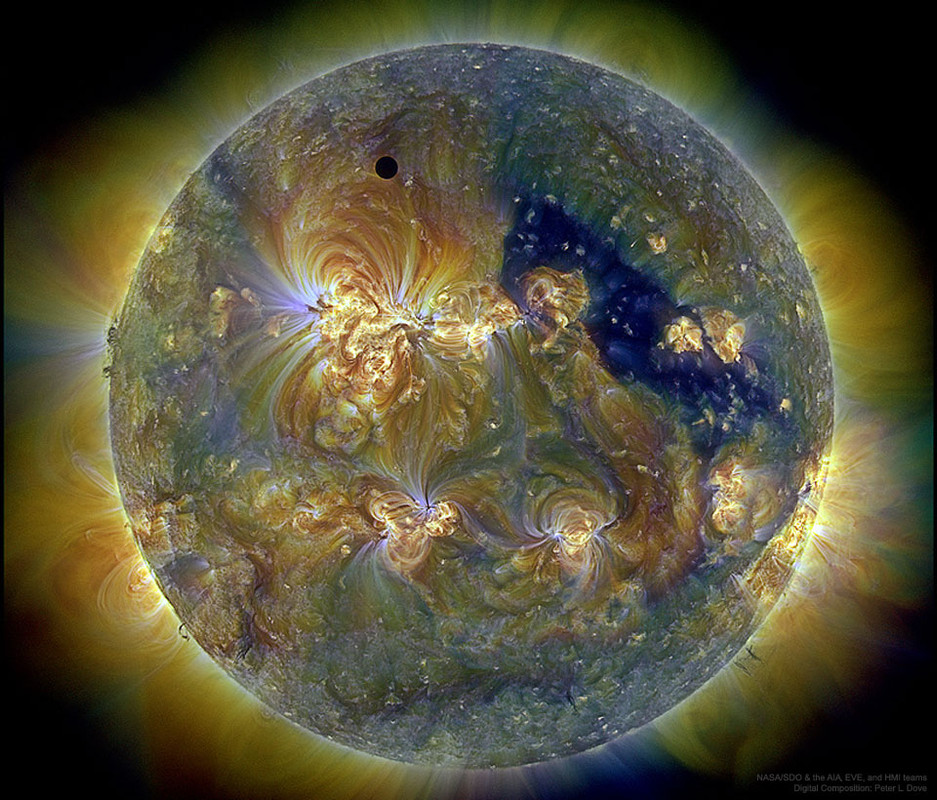
The Crab Nebula is cataloged as M1, the first object on Charles Messier's famous list of things which are not comets. In fact, the Crab is now known to be a supernova remnant, expanding debris from massive star's death explosion, witnessed on planet Earth in 1054 AD. This brave new image offers a 21st century view of the Crab Nebula by presenting image data from across the electromagnetic spectrum as wavelengths of visible light. From space, Chandra (X-ray) XMM-Newton (ultraviolet), Hubble (visible), and Spitzer (infrared), data are in purple, blue, green, and yellow hues. From the ground, Very Large Array radio wavelength data is shown in red. One of the most exotic objects known to modern astronomers, the Crab Pulsar, a neutron star spinning 30 times a second, is the bright spot near picture center. Like a cosmic dynamo, this collapsed remnant of the stellar core powers the Crab's emission across the electromagnetic spectrum. Spanning about 12 light-years, the Crab Nebula is 6,500 light-years away in the constellation Taurus.
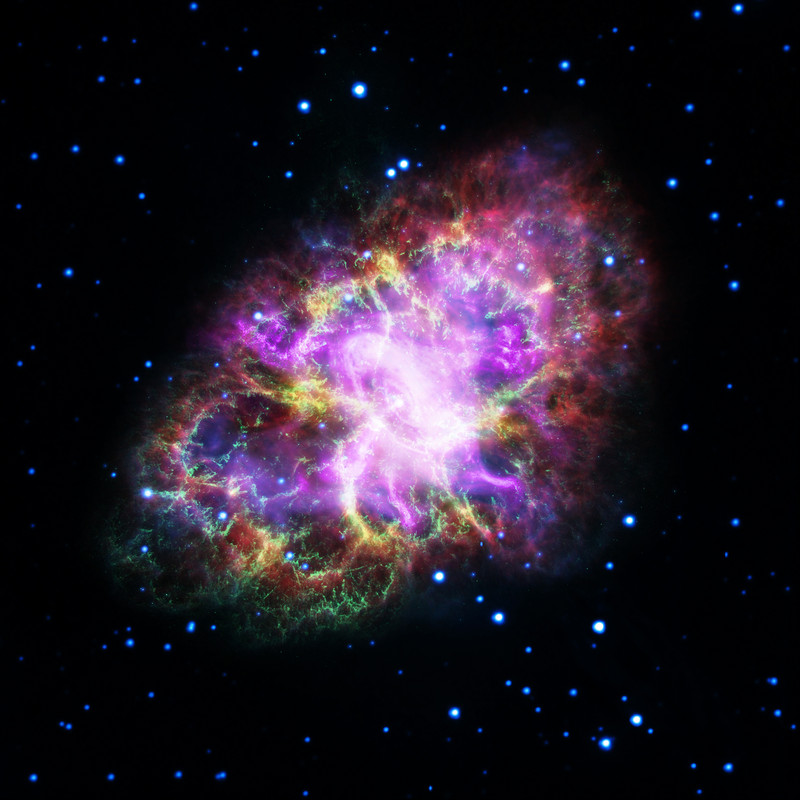
Can you see the lion? A deep exposure shows the famous dark indentation that looks like a horse's head, visible just left and below center, and known unsurprisingly as the Horsehead Nebula. The Horsehead Nebula (Barnard 33) is part of a vast complex of dark absorbing dust and bright glowing gas. To bring out details of the Horsehead's pasture, an astrophotographer artistically combined light accumulated for over 20 hours in hydrogen (orange), oxygen (blue), and sulfur (green). The resulting spectacular picture captured from Raachine, Lebanon, details an intricate tapestry of gaseous wisps and dust-laden filaments that were created and sculpted over eons by stellar winds and ancient supernovas. The featured composition brings up another pareidolic animal icon -- that of a lion's head -- in the expansive orange colored gas above the horse's head. The Flame Nebula is visible just to the left of the Horsehead. The Horsehead Nebula lies 1,500 light years distant towards the constellation of Orion.
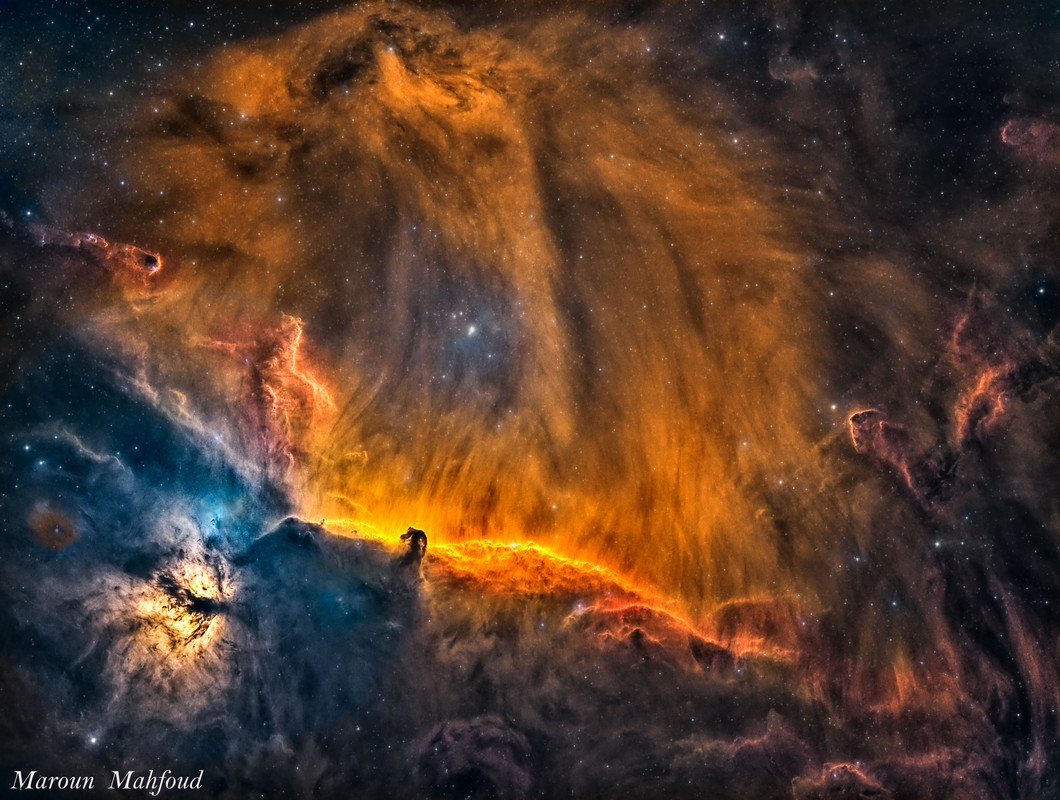
Another, "My God, it's full of stars"...Globular star cluster 47 Tucanae is a jewel of the southern sky. Also known as NGC 104, it roams the halo of our Milky Way Galaxy along with some 200 other globular star clusters. The second brightest globular cluster (after Omega Centauri) as seen from planet Earth, 47 Tuc lies about 13,000 light-years away. It can be spotted with the naked-eye close on the sky to the Small Magellanic Cloud in the constellation of the Toucan. The dense cluster is made up of hundreds of thousands of stars in a volume only about 120 light-years across. Red giant stars on the outskirts of the cluster are easy to pick out as yellowish stars in this sharp telescopic portrait. Tightly packed globular cluster 47 Tuc is also home to a star with the closest known orbit around a black hole.

How far can you see? Everything you can see, and everything you could possibly see, right now, assuming your eyes could detect all types of radiations around you -- is the observable universe. In light, the farthest we can see comes from the cosmic microwave background, a time 13.8 billion years ago when the universe was opaque like thick fog. Some neutrinos and gravitational waves that surround us come from even farther out, but humanity does not yet have the technology to detect them. The featured image illustrates the observable universe on an increasingly compact scale, with the Earth and Sun at the center surrounded by our Solar System, nearby stars, nearby galaxies, distant galaxies, filaments of early matter, and the cosmic microwave background. Cosmologists typically assume that our observable universe is just the nearby part of a greater entity known as "the universe" where the same physics applies. However, there are several lines of popular but speculative reasoning that assert that even our universe is part of a greater multiverse where either different physical constants occur, different physical laws apply, higher dimensions operate, or slightly different-by-chance versions of our standard universe exist.
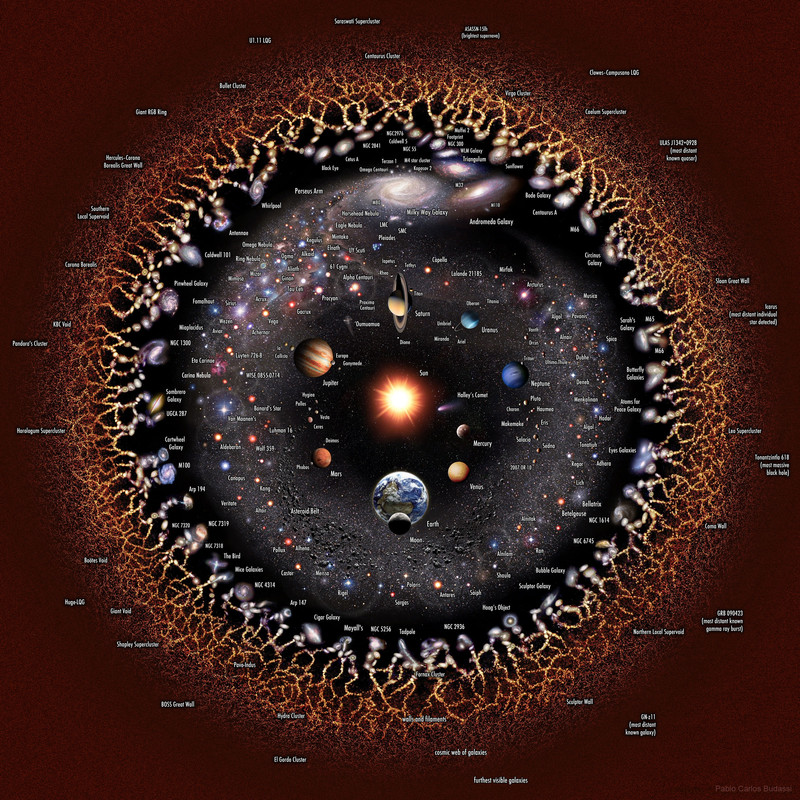

This was a very unusual type of solar eclipse. Typically, it is the Earth's Moon that eclipses the Sun. In 2012, though, the planet Venus took a turn. Like a solar eclipse by the Moon, the phase of Venus became a continually thinner crescent as Venus became increasingly better aligned with the Sun. Eventually the alignment became perfect and the phase of Venus dropped to zero. The dark spot of Venus crossed our parent star. The situation could technically be labeled a Venusian annular eclipse with an extraordinarily large ring of fire. Pictured here during the occultation, the Sun was imaged in three colors of ultraviolet light by the Earth-orbiting Solar Dynamics Observatory, with the dark region toward the right corresponding to a coronal hole. Hours later, as Venus continued in its orbit, a slight crescent phase appeared again. The next Venusian transit across the Sun will occur in 2117.

The Crab Nebula is cataloged as M1, the first object on Charles Messier's famous list of things which are not comets. In fact, the Crab is now known to be a supernova remnant, expanding debris from massive star's death explosion, witnessed on planet Earth in 1054 AD. This brave new image offers a 21st century view of the Crab Nebula by presenting image data from across the electromagnetic spectrum as wavelengths of visible light. From space, Chandra (X-ray) XMM-Newton (ultraviolet), Hubble (visible), and Spitzer (infrared), data are in purple, blue, green, and yellow hues. From the ground, Very Large Array radio wavelength data is shown in red. One of the most exotic objects known to modern astronomers, the Crab Pulsar, a neutron star spinning 30 times a second, is the bright spot near picture center. Like a cosmic dynamo, this collapsed remnant of the stellar core powers the Crab's emission across the electromagnetic spectrum. Spanning about 12 light-years, the Crab Nebula is 6,500 light-years away in the constellation Taurus.

Can you see the lion? A deep exposure shows the famous dark indentation that looks like a horse's head, visible just left and below center, and known unsurprisingly as the Horsehead Nebula. The Horsehead Nebula (Barnard 33) is part of a vast complex of dark absorbing dust and bright glowing gas. To bring out details of the Horsehead's pasture, an astrophotographer artistically combined light accumulated for over 20 hours in hydrogen (orange), oxygen (blue), and sulfur (green). The resulting spectacular picture captured from Raachine, Lebanon, details an intricate tapestry of gaseous wisps and dust-laden filaments that were created and sculpted over eons by stellar winds and ancient supernovas. The featured composition brings up another pareidolic animal icon -- that of a lion's head -- in the expansive orange colored gas above the horse's head. The Flame Nebula is visible just to the left of the Horsehead. The Horsehead Nebula lies 1,500 light years distant towards the constellation of Orion.

Another, "My God, it's full of stars"...Globular star cluster 47 Tucanae is a jewel of the southern sky. Also known as NGC 104, it roams the halo of our Milky Way Galaxy along with some 200 other globular star clusters. The second brightest globular cluster (after Omega Centauri) as seen from planet Earth, 47 Tuc lies about 13,000 light-years away. It can be spotted with the naked-eye close on the sky to the Small Magellanic Cloud in the constellation of the Toucan. The dense cluster is made up of hundreds of thousands of stars in a volume only about 120 light-years across. Red giant stars on the outskirts of the cluster are easy to pick out as yellowish stars in this sharp telescopic portrait. Tightly packed globular cluster 47 Tuc is also home to a star with the closest known orbit around a black hole.

How far can you see? Everything you can see, and everything you could possibly see, right now, assuming your eyes could detect all types of radiations around you -- is the observable universe. In light, the farthest we can see comes from the cosmic microwave background, a time 13.8 billion years ago when the universe was opaque like thick fog. Some neutrinos and gravitational waves that surround us come from even farther out, but humanity does not yet have the technology to detect them. The featured image illustrates the observable universe on an increasingly compact scale, with the Earth and Sun at the center surrounded by our Solar System, nearby stars, nearby galaxies, distant galaxies, filaments of early matter, and the cosmic microwave background. Cosmologists typically assume that our observable universe is just the nearby part of a greater entity known as "the universe" where the same physics applies. However, there are several lines of popular but speculative reasoning that assert that even our universe is part of a greater multiverse where either different physical constants occur, different physical laws apply, higher dimensions operate, or slightly different-by-chance versions of our standard universe exist.

vapviking
Old & In the Way
I used the artist-rendered image (below) for years as my avatar picture here on FC! (but I think as a thumbnail it looks rather like an eyeball's pupil).
The Entire Observable Universe, credit to Pablo Carlos Budassi (same author as the image in @CrazyDiamond's post above.
 www.pablocarlosbudassi.com
www.pablocarlosbudassi.com
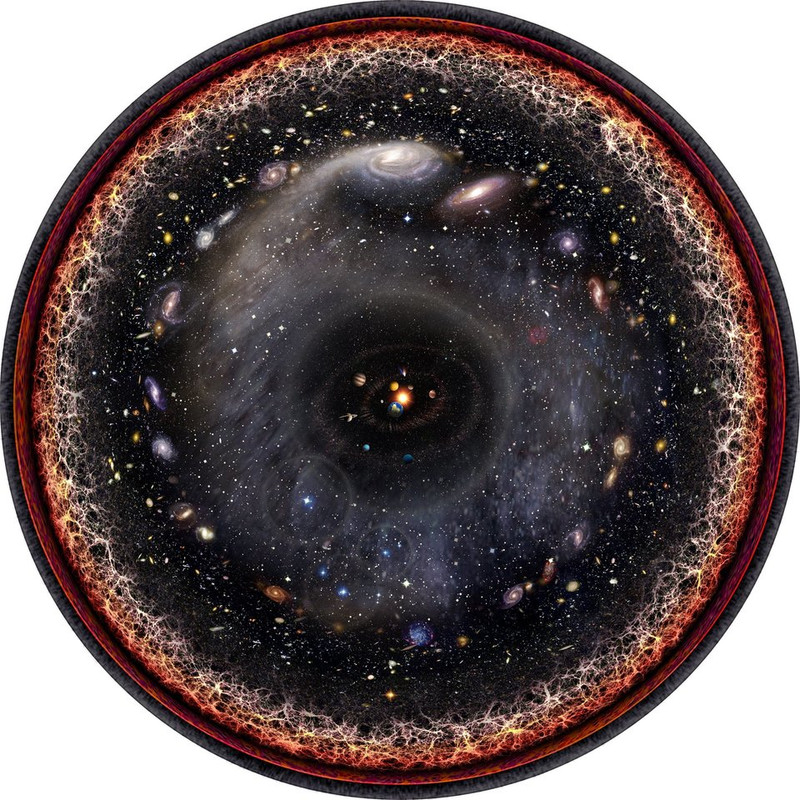
Here's the Nature Time Spiral
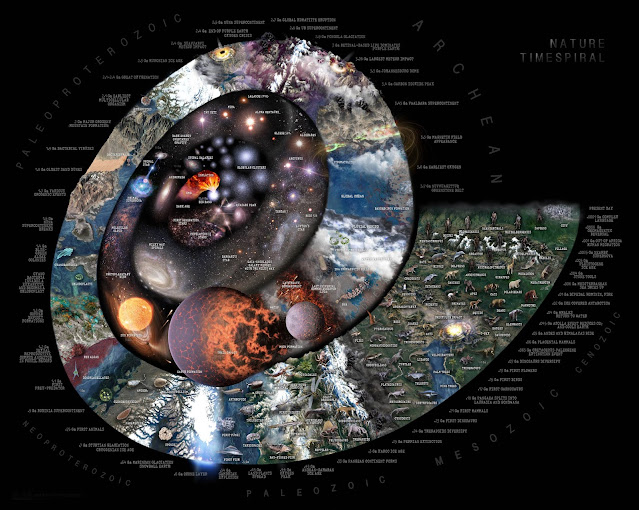
The Entire Observable Universe, credit to Pablo Carlos Budassi (same author as the image in @CrazyDiamond's post above.
Home - Pablo Carlos Budassi
'Every person’s map of the world is as unique as the pattern of their iris.'
 www.pablocarlosbudassi.com
www.pablocarlosbudassi.com

Here's the Nature Time Spiral

CrazyDiamond
HAL is a StarChild
And your current avatar is pretty awesome as well @vapviking...GD dancing bear, I miss Jerry still. And speaking of nature, my current favorite band, for the past 4 years, is Goose (not the Goose band from Europe). Its been really cool to see them evolve...drummer getting bigger kit, keyboard/guitar adding classic keyboards like the Clavinet and Hammond B3...adding a percussionist...and they play some great, unexpected covers and post whole shows to their youtube channel...you all should check them out.
Back on topic...
A mere 11 million light-years away, Centaurus A is the closest active galaxy to planet Earth. Spanning over 60,000 light-years, the peculiar elliptical galaxy also known as NGC 5128, is featured in this sharp telescopic view. Centaurus A is apparently the result of a collision of two otherwise normal galaxies resulting in a fantastic jumble of star clusters and imposing dark dust lanes. Near the galaxy's center, leftover cosmic debris is steadily being consumed by a central black hole with a billion times the mass of the Sun. As in other active galaxies, that process likely generates the enormous radio, X-ray, and gamma-ray energy radiated by Centaurus A.
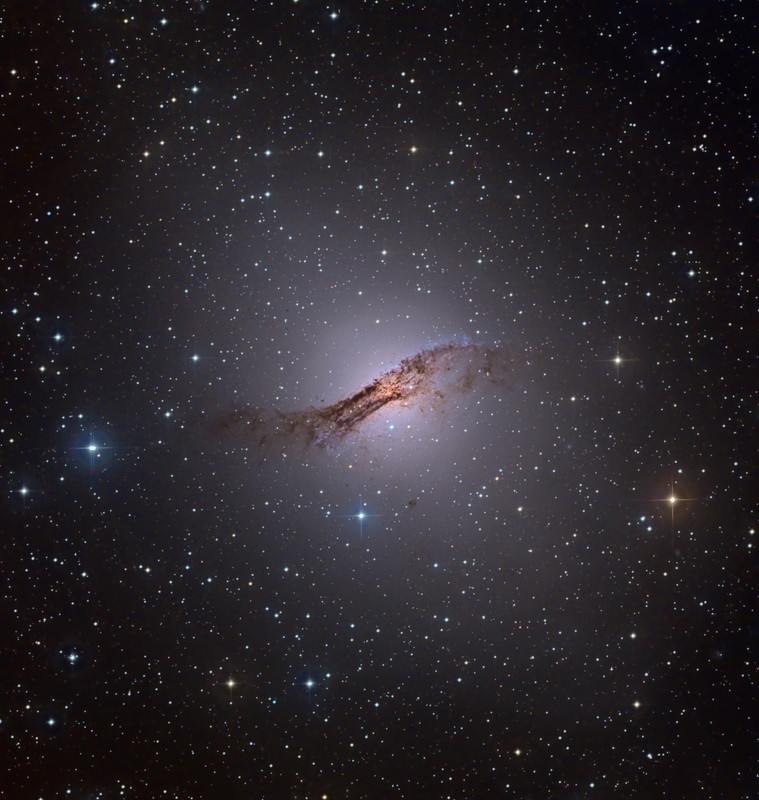
Bluish reflection nebulae seem to fill this dusty expanse. The sharp telescopic frame spans over 1 degree on the sky toward the faint but fanciful constellation Monoceros, the Unicorn. Seen within the Monoceros R1 cloud complex some 2,500 light-years away, bluish IC 447 is on the left, joined by a long dark filament of dust to IC 446 at lower right. Embedded in IC 447 are young, massive blue stars much hotter than the Sun, whose light is reflected by the cosmic cloud of star stuff. Observations reveal that IC 446 also contains a young stellar object, a massive star still in an early stage of evolution. The dark filament of dust and molecular gas joining the two star-forming regions is over 15 light-years long.

This striking image from the NASA/ESA Hubble Space Telescope showcases Arp 298, a stunning pair of interacting galaxies. Arp 298 – which comprises the two galaxies NGC 7469 and IC 5283 – lies roughly 200 million light-years from Earth in the constellation Pegasus. The larger of the two galaxies pictured here is the barred spiral galaxy NGC 7469, and IC 5283 is its diminutive companion. NGC 7469 is also host to an active, supermassive black hole and a bright ring of star clusters.
The “Arp” in this galaxy pair’s name signifies that they are listed in the Atlas of Peculiar Galaxies compiled by the astronomer Halton Arp. The Atlas of Peculiar Galaxies is a gallery of weird and wonderful galaxies containing peculiar structures, featuring galaxies exhibiting everything from segmented spiral arms to concentric rings. This interacting galaxy pair is a familiar sight for Hubble – a portrait of the merging galaxies in Arp 298 was published in 2008.
This image of Arp 298, which also contains several background galaxies, contains data from three separate Hubble observing proposals. By combining observations from three proposals, Arp 298 is captured in glorious detail in seven different filters from two of Hubble’s instruments – the Wide Field Camera 3 and the Advanced Camera for Surveys.
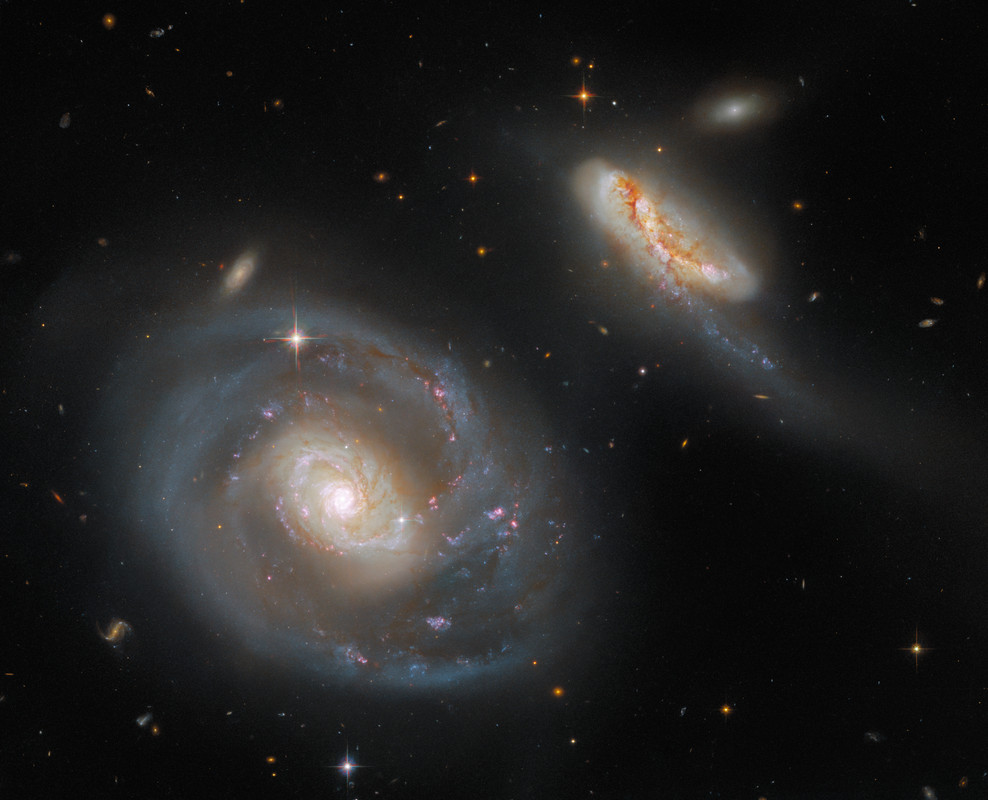
The universe emits light or energy in many different forms. This object is, in fact, a pair: a white dwarf star that steadily burns at a relatively cool temperature and a highly variable red giant. As they orbit each other, the white dwarf pulls material from the red giant onto its surface. Over time, enough of this material accumulates and triggers an explosion. Astronomers have seen such outbursts over recent decades. Evidence for much older outbursts is seen in the spectacular structures observed by NASA's Hubble Space Telescope (red and blue). X-ray data from Chandra (purple) shows how a jet from the white dwarf is striking material surrounding it and creating shock waves, similar to sonic booms from supersonic planes.
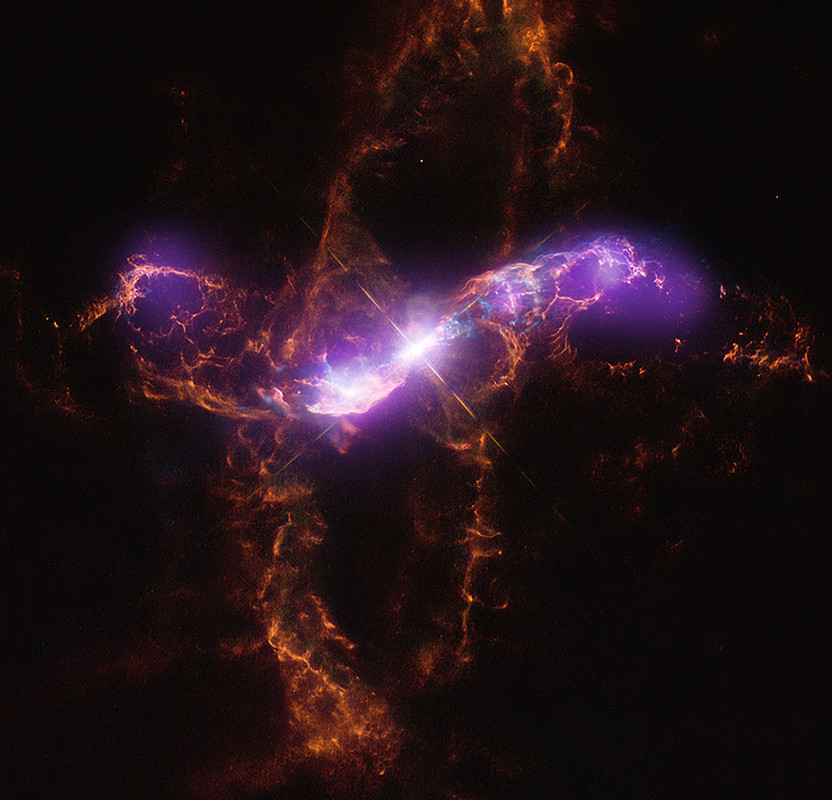
Back on topic...
A mere 11 million light-years away, Centaurus A is the closest active galaxy to planet Earth. Spanning over 60,000 light-years, the peculiar elliptical galaxy also known as NGC 5128, is featured in this sharp telescopic view. Centaurus A is apparently the result of a collision of two otherwise normal galaxies resulting in a fantastic jumble of star clusters and imposing dark dust lanes. Near the galaxy's center, leftover cosmic debris is steadily being consumed by a central black hole with a billion times the mass of the Sun. As in other active galaxies, that process likely generates the enormous radio, X-ray, and gamma-ray energy radiated by Centaurus A.

Bluish reflection nebulae seem to fill this dusty expanse. The sharp telescopic frame spans over 1 degree on the sky toward the faint but fanciful constellation Monoceros, the Unicorn. Seen within the Monoceros R1 cloud complex some 2,500 light-years away, bluish IC 447 is on the left, joined by a long dark filament of dust to IC 446 at lower right. Embedded in IC 447 are young, massive blue stars much hotter than the Sun, whose light is reflected by the cosmic cloud of star stuff. Observations reveal that IC 446 also contains a young stellar object, a massive star still in an early stage of evolution. The dark filament of dust and molecular gas joining the two star-forming regions is over 15 light-years long.

This striking image from the NASA/ESA Hubble Space Telescope showcases Arp 298, a stunning pair of interacting galaxies. Arp 298 – which comprises the two galaxies NGC 7469 and IC 5283 – lies roughly 200 million light-years from Earth in the constellation Pegasus. The larger of the two galaxies pictured here is the barred spiral galaxy NGC 7469, and IC 5283 is its diminutive companion. NGC 7469 is also host to an active, supermassive black hole and a bright ring of star clusters.
The “Arp” in this galaxy pair’s name signifies that they are listed in the Atlas of Peculiar Galaxies compiled by the astronomer Halton Arp. The Atlas of Peculiar Galaxies is a gallery of weird and wonderful galaxies containing peculiar structures, featuring galaxies exhibiting everything from segmented spiral arms to concentric rings. This interacting galaxy pair is a familiar sight for Hubble – a portrait of the merging galaxies in Arp 298 was published in 2008.
This image of Arp 298, which also contains several background galaxies, contains data from three separate Hubble observing proposals. By combining observations from three proposals, Arp 298 is captured in glorious detail in seven different filters from two of Hubble’s instruments – the Wide Field Camera 3 and the Advanced Camera for Surveys.

The universe emits light or energy in many different forms. This object is, in fact, a pair: a white dwarf star that steadily burns at a relatively cool temperature and a highly variable red giant. As they orbit each other, the white dwarf pulls material from the red giant onto its surface. Over time, enough of this material accumulates and triggers an explosion. Astronomers have seen such outbursts over recent decades. Evidence for much older outbursts is seen in the spectacular structures observed by NASA's Hubble Space Telescope (red and blue). X-ray data from Chandra (purple) shows how a jet from the white dwarf is striking material surrounding it and creating shock waves, similar to sonic booms from supersonic planes.

CrazyDiamond
HAL is a StarChild
BTW, since going to postimage for my posts, I upload the largest image possible for each one, it's just a couple more mouse clicks to download the full OG pic....when I used imagur, I would have resize them to a certain size to be able to post here. I guess less steps for me as I don't have to do the photoshop resizing, but sucks that all the ones from before are gone. I'll re-post them but not with the explanations.
vapviking
Old & In the Way
Moonrise at Sunset
I'm not sure if I can do any better with posting this pic; it was done on panoramic setting with my phone.
On the beach at Fire Island, NY a couple of years ago.
So, the line of the beach at waterfront was straight, now bent by the shot.
I shot looking up the beach to the east (see the moon on the horizon, on the left?) and panned across the water/horizon all the way to looking up beach to the west, so on the right sun has set just beyond the houses.
Click on the photo for a better view

I'm not sure if I can do any better with posting this pic; it was done on panoramic setting with my phone.
On the beach at Fire Island, NY a couple of years ago.
So, the line of the beach at waterfront was straight, now bent by the shot.
I shot looking up the beach to the east (see the moon on the horizon, on the left?) and panned across the water/horizon all the way to looking up beach to the west, so on the right sun has set just beyond the houses.
Click on the photo for a better view

Last edited:
CrazyDiamond
HAL is a StarChild
These are some of the largest file size images I've uploaded, be sure to open them to the OG file uploaded...
NGC 6188 The Dragons of Ara-NGC 6188 is an emission nebula located about 4,000 light years away in the constellation Ara. The bright open cluster NGC 6193, visible to the naked eye, is responsible for a region of reflection nebulosity within NGC 6188. NGC 6188 is a star forming nebula, and is sculpted by the massive, young stars that have recently formed there – some are only a few million years old.

Ctb1 Abell 85. A supernova remnant. It's size in the sky is similar to the size of a full moon. It's outer shell has ruptured between the 4 and 5 o'clock position. Originally this was thought to be a Planetary nebula (Abell 85) but in 1971 it was determined that is actually a supernova remnant.
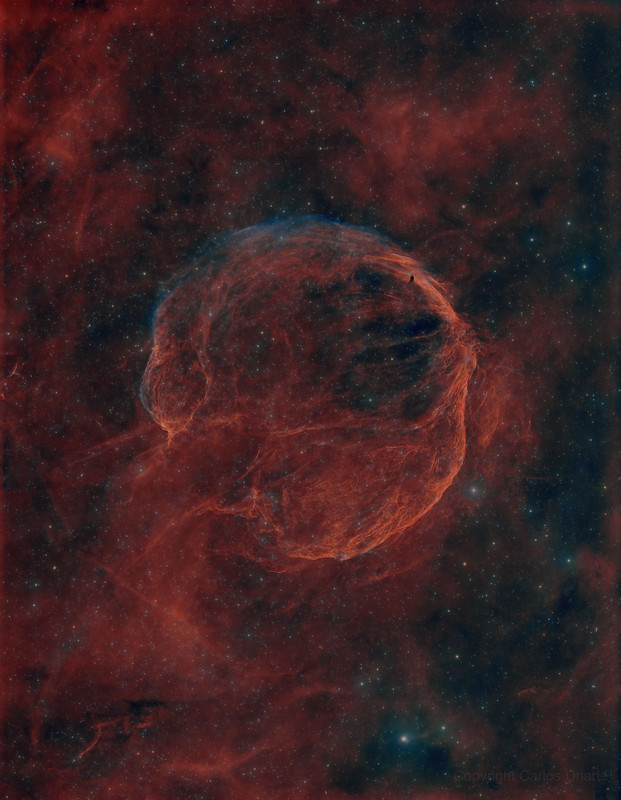
Two frame mosaic of Orion Belt region shot with Telescope Live's FSQ 106.
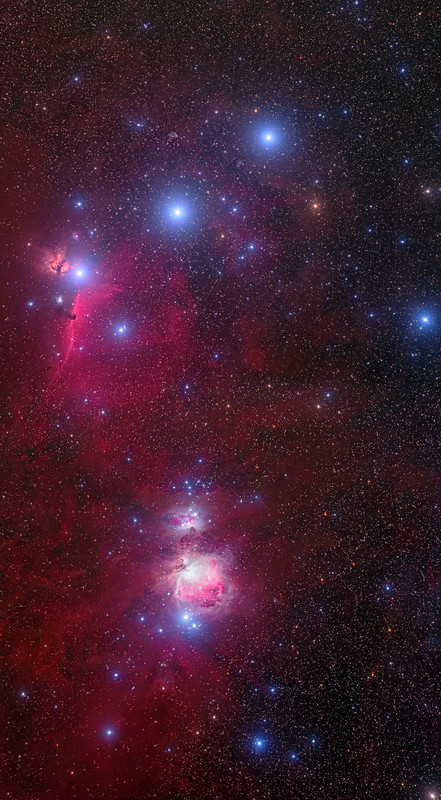
NGC 2070 Tarantula Nebula-NGC 2070 (also known as Caldwell 103) is a large open cluster and candidate super star cluster forming the heart of the bright region in the center-south-east of the Large Magellanic Cloud. It is at the center of the Tarantula Nebula and produces most of the energy that makes the latter's gas and dust visible. Its central condensation is the star cluster R136, one of the most energetic star clusters known.
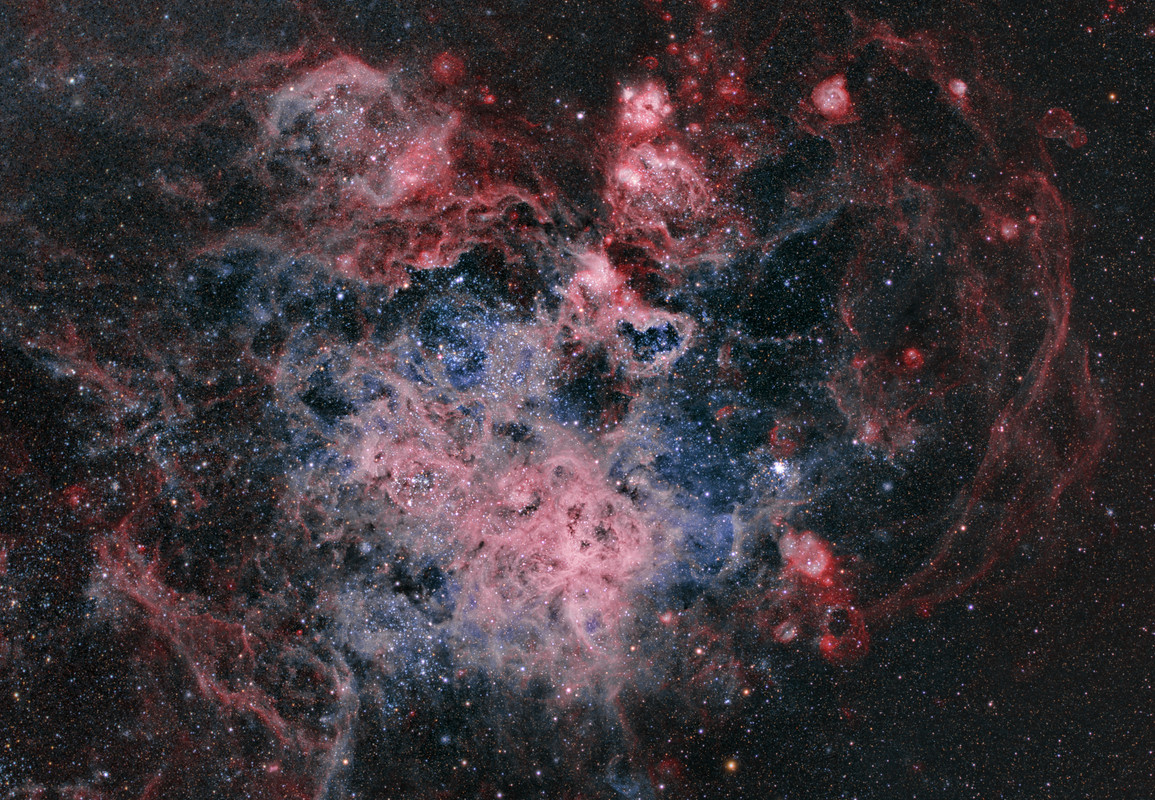
Sh2-308, also designated as Sharpless 308 is an H II region located near the center of the constellation Canis Major, composed of ionized hydrogen. The nebula is bubble-like and surrounds a Wolf–Rayet star named EZ Canis Majoris. This star is in the brief, pre-supernova phase of its stellar evolution. The nebula is about 4,530 light-years away from Earth. Image is taken over 9 nights between 16 February and 25 February 2022.

NGC 3293 - Gem Cluster, and part of NGC 3324 - Gabriela Mistral Nebula
NGC 3293 is an open cluster in the Carina constellation. It was discovered by Nicolas-Louis de Lacaille in 1751. It consists of more than 100 stars brighter than 14th magnitude in a 10 arc minute field, the brightest of which are blue supergiants of apparent magnitude 6.5 and 6.7. There is also a 7th magnitude pulsating red supergiant, V361 Carinae.
NGC 3324 is an open cluster in the southern constellation Carina, located northwest of the Carina Nebula (NGC 3372) at a distance of 9,100 ly (2,800 pc) from Earth. It is closely associated with the emission nebula IC 2599, also known as Gum 31. The two are often confused as a single object, and together have been nicknamed the "Gabriela Mistral Nebula" due to its resemblance to the Chilean poet.
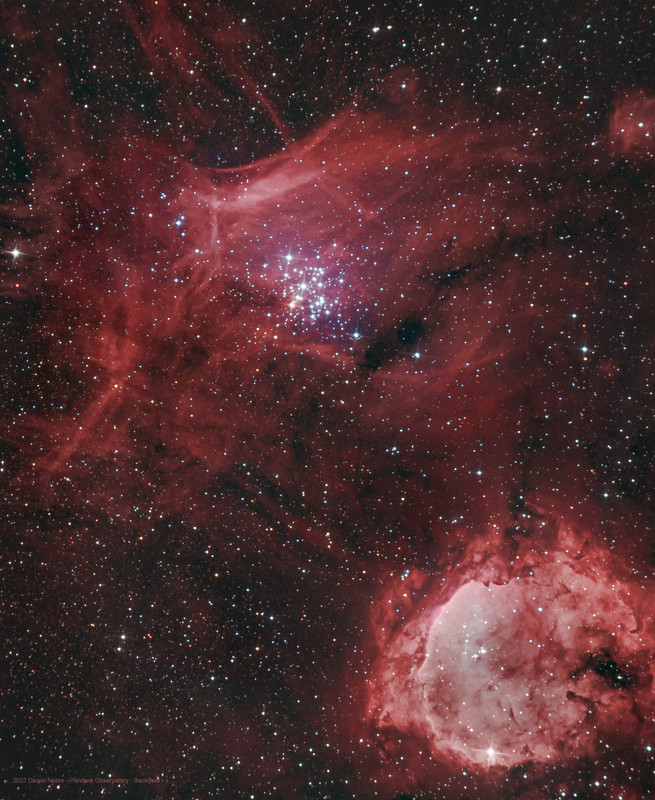
NGC 6188 The Dragons of Ara-NGC 6188 is an emission nebula located about 4,000 light years away in the constellation Ara. The bright open cluster NGC 6193, visible to the naked eye, is responsible for a region of reflection nebulosity within NGC 6188. NGC 6188 is a star forming nebula, and is sculpted by the massive, young stars that have recently formed there – some are only a few million years old.

Ctb1 Abell 85. A supernova remnant. It's size in the sky is similar to the size of a full moon. It's outer shell has ruptured between the 4 and 5 o'clock position. Originally this was thought to be a Planetary nebula (Abell 85) but in 1971 it was determined that is actually a supernova remnant.

Two frame mosaic of Orion Belt region shot with Telescope Live's FSQ 106.

NGC 2070 Tarantula Nebula-NGC 2070 (also known as Caldwell 103) is a large open cluster and candidate super star cluster forming the heart of the bright region in the center-south-east of the Large Magellanic Cloud. It is at the center of the Tarantula Nebula and produces most of the energy that makes the latter's gas and dust visible. Its central condensation is the star cluster R136, one of the most energetic star clusters known.

Sh2-308, also designated as Sharpless 308 is an H II region located near the center of the constellation Canis Major, composed of ionized hydrogen. The nebula is bubble-like and surrounds a Wolf–Rayet star named EZ Canis Majoris. This star is in the brief, pre-supernova phase of its stellar evolution. The nebula is about 4,530 light-years away from Earth. Image is taken over 9 nights between 16 February and 25 February 2022.

NGC 3293 - Gem Cluster, and part of NGC 3324 - Gabriela Mistral Nebula
NGC 3293 is an open cluster in the Carina constellation. It was discovered by Nicolas-Louis de Lacaille in 1751. It consists of more than 100 stars brighter than 14th magnitude in a 10 arc minute field, the brightest of which are blue supergiants of apparent magnitude 6.5 and 6.7. There is also a 7th magnitude pulsating red supergiant, V361 Carinae.
NGC 3324 is an open cluster in the southern constellation Carina, located northwest of the Carina Nebula (NGC 3372) at a distance of 9,100 ly (2,800 pc) from Earth. It is closely associated with the emission nebula IC 2599, also known as Gum 31. The two are often confused as a single object, and together have been nicknamed the "Gabriela Mistral Nebula" due to its resemblance to the Chilean poet.

stark1
Lonesome Planet
At the end of the last Century there was much ado about flat rotation curves and their implications.
Since then astronomers have been scratching their heads while searching for the missing, unobservable, “dark” matter, which would account for the fast, flat orbital velocities of stars found on the outer radius of galaxies.
In the second decade of the new Century however, a new conundrum has been added
To the mix.
Two galaxies, perhaps six, anomalies: Galaxies believed to be dark matter poor, or ultra-low luminosity galaxies.
Compared to the Milky Way, they contain 1%, a thousand times less, stars, so diffused background objects can be seen through them.
Their rotation curves follow the standard model of Newtonian physics. That is,
The stars far from their centers rotate slower than those closer to the center.
Which implies that there is little or no dark matter in these ultra-diffuse galaxies.


Note background elongated galaxies through the ULL galaxy
The formation mechanisms for these anomalous dark matter poor galaxies?
Well, we will find out when astronomers unravel the mystery.
Meanwhile, it has been suggested that when these galaxies pass through a larger galaxy, while most of the dust
And stars—and dark matter, were stripped away, with at most some of the higher velocity stars emerging intact,
Produced these star sparse ultra-low luminosity, missing dark matter galaxies.
Jury is still out.

Another galaxy with missing dark matter, AGC114905

Because of their ultra low luminosity, these ULL galaxies are difficult to detect in the visual spectrum, altho mathematical calculations seem to indicate that there may be many more yet to be found.
Since then astronomers have been scratching their heads while searching for the missing, unobservable, “dark” matter, which would account for the fast, flat orbital velocities of stars found on the outer radius of galaxies.
In the second decade of the new Century however, a new conundrum has been added
To the mix.
Two galaxies, perhaps six, anomalies: Galaxies believed to be dark matter poor, or ultra-low luminosity galaxies.
Compared to the Milky Way, they contain 1%, a thousand times less, stars, so diffused background objects can be seen through them.
Their rotation curves follow the standard model of Newtonian physics. That is,
The stars far from their centers rotate slower than those closer to the center.
Which implies that there is little or no dark matter in these ultra-diffuse galaxies.
NGC 1052-DF2

NGC 1052-DF4

Note background elongated galaxies through the ULL galaxy
The formation mechanisms for these anomalous dark matter poor galaxies?
Well, we will find out when astronomers unravel the mystery.
Meanwhile, it has been suggested that when these galaxies pass through a larger galaxy, while most of the dust
And stars—and dark matter, were stripped away, with at most some of the higher velocity stars emerging intact,
Produced these star sparse ultra-low luminosity, missing dark matter galaxies.
Jury is still out.


Another galaxy with missing dark matter, AGC114905

Because of their ultra low luminosity, these ULL galaxies are difficult to detect in the visual spectrum, altho mathematical calculations seem to indicate that there may be many more yet to be found.
Last edited:
stark1
Lonesome Planet
The Flip Side
Not all ultra diffuse galaxies are dark matter poor.
Take Dragonfly 44. A galaxy about the size of the Milky Way, but with the stellar content
An order of magnitude less than the MW, with 160 billion ☉ mass.
When stellar velocities, and spectral analysis, in 2016 were taken over some time, astronomers concluded
That the Dragonfly Telephoto Array may have found a galaxy made almost entirely of dark matter.
Go figure.
Stay tuned.

Note the morphology of DMP galaxies is elliptical, while DMR Dragonfly 44 above seems lenticular.
Not all ultra diffuse galaxies are dark matter poor.
Take Dragonfly 44. A galaxy about the size of the Milky Way, but with the stellar content
An order of magnitude less than the MW, with 160 billion ☉ mass.
When stellar velocities, and spectral analysis, in 2016 were taken over some time, astronomers concluded
That the Dragonfly Telephoto Array may have found a galaxy made almost entirely of dark matter.
Go figure.
Stay tuned.

Note the morphology of DMP galaxies is elliptical, while DMR Dragonfly 44 above seems lenticular.
Last edited:
CrazyDiamond
HAL is a StarChild
Massive stars can blow bubbles. The featured image shows perhaps the most famous of all star-bubbles, NGC 7635, also known simply as The Bubble Nebula. Although it looks delicate, the 7-light-year diameter bubble offers evidence of violent processes at work. Above and left of the Bubble's center is a hot, O-type star, several hundred thousand times more luminous and some 45-times more massive than the Sun. A fierce stellar wind and intense radiation from that star has blasted out the structure of glowing gas against denser material in a surrounding molecular cloud. The intriguing Bubble Nebula and associated cloud complex lie a mere 7,100 light-years away toward the boastful constellation Cassiopeia. This sharp, tantalizing view of the cosmic bubble is a reprocessed composite of previously acquired Hubble Space Telescope image data.
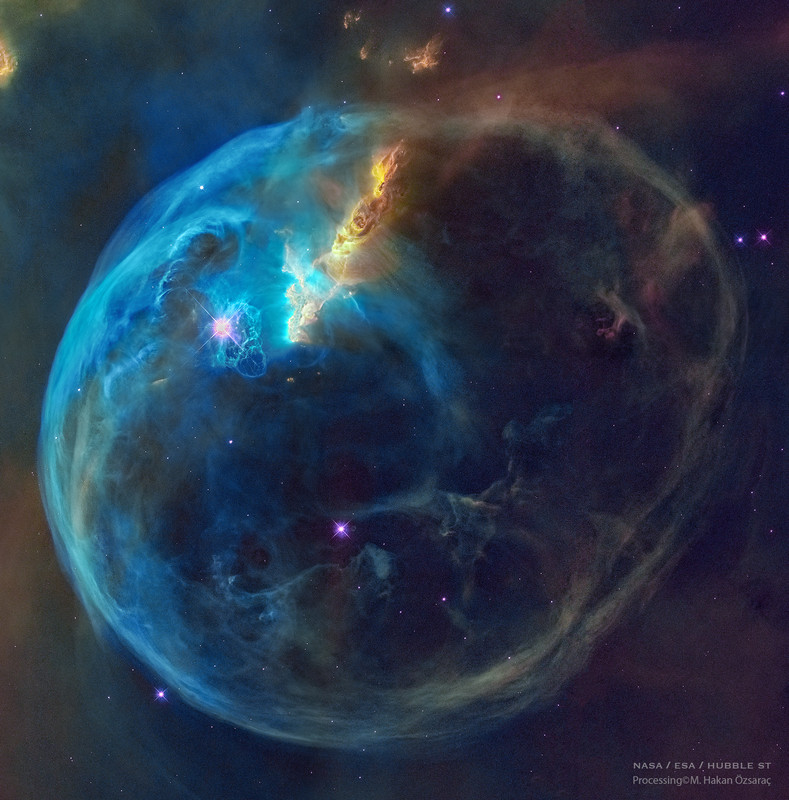
There are so many galaxies in the background its unreal...
Peculiar spiral galaxy Arp 78 is found within the boundaries of the head strong constellation Aries. Some 100 million light-years beyond the stars and nebulae of our Milky Way galaxy, the island universe is over 100,000 light-years across. Also known as NGC 772, it sports a prominent, outer spiral arm in this detailed cosmic portrait from the large Gemini North telescope near the summit of Maunakea, Hawaii, planet Earth. Tracking along sweeping dust lanes and lined with young blue star clusters, Arp 78's spiral arm is likely pumped-up by galactic-scale gravitational tidal interactions The close companion galaxy responsible is NGC 770, located off the upper right of this frame. But more distant background galaxies are clearly visible in the cosmic field of view.

The night side of Pluto spans this shadowy scene. In the stunning spacebased perspective the Sun is 4.9 billion kilometers (almost 4.5 light-hours) behind the dim and distant world. It was captured by far flung New Horizons in July of 2015 when the spacecraft was at a range of some 21,000 kilometers from Pluto, about 19 minutes after its closest approach. A denizen of the Kuiper Belt in dramatic silhouette, the image also reveals Pluto's tenuous, surprisingly complex layers of hazy atmosphere. Near the top of the frame the crescent twilight landscape includes southern areas of nitrogen ice plains now formally known as Sputnik Planitia and rugged mountains of water-ice in the Norgay Montes.
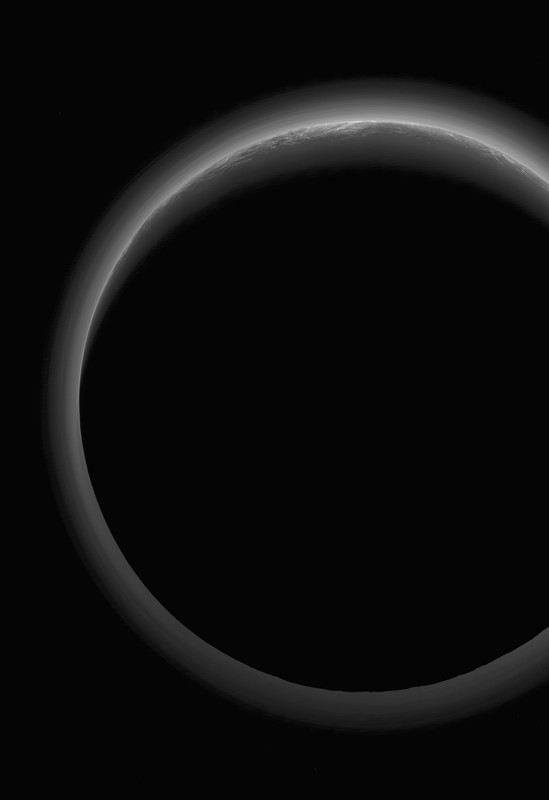
Why would the surface of Titan light up with a blinding flash? The reason: a sunglint from liquid seas. Saturn's moon Titan has numerous smooth lakes of methane that, when the angle is right, reflect sunlight as if they were mirrors. Pictured here in false-color, the robotic Cassini spacecraft that orbited Saturn from 2004 to 2017 imaged the cloud-covered Titan in 2014 in different bands of cloud-piercing infrared light. This spectacular reflection was so bright it saturated one of Cassini's infrared cameras. Although the sunglint was annoying -- it was also useful. The reflecting regions confirm that northern Titan houses a wide and complex array of seas with a geometry that indicates periods of significant evaporation. During its numerous passes of our Solar System's most mysterious moon, Cassini has revealed Titan to be a world with active weather -- including times when it rains a liquefied version of natural gas.
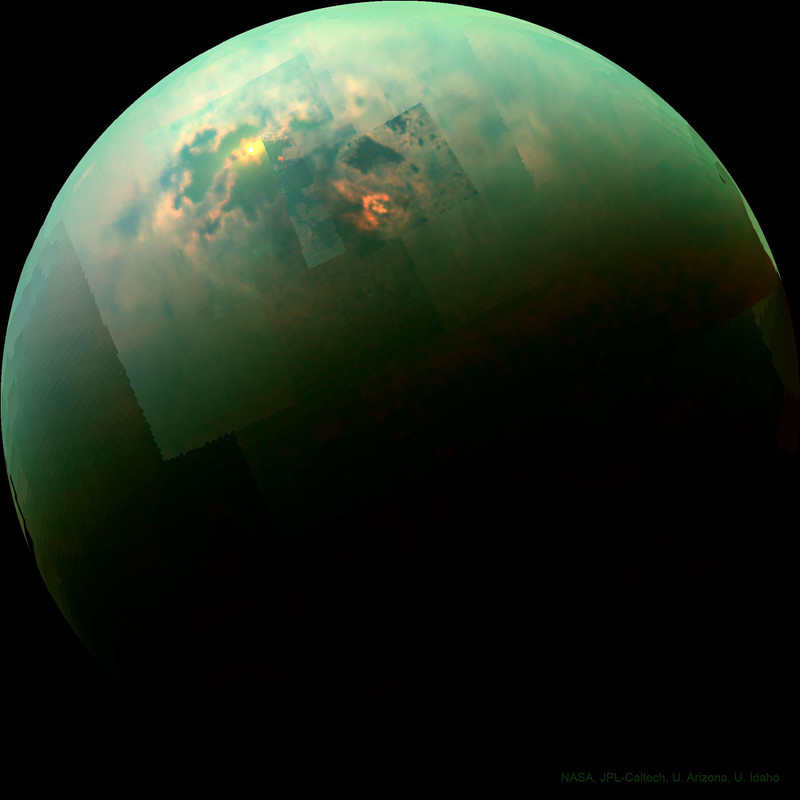
Color-composite image of the Carina Nebula, revealing exquisite details in the stars and dust of the region. Several well known astronomical objects can be seen in this wide field image : to the bottom left of the image is one of the most impressive binary stars in the Universe, Eta Carinae, with the famous Keyhole Nebula just adjacent to the star. The collection of very bright, young stars above and to the right of Eta Carinae is the open star cluster Trumpler 14. A second open star cluster, Collinder 228 is also seen in the image, just below Eta Carinae. The Carina Nebula also bears the NGC 3372 designation. On this image, North is up and East is to the left. The field of view is 0.55 x 0.55 degrees, covering a 72 x 72 light-year region at the distance of the nebula.
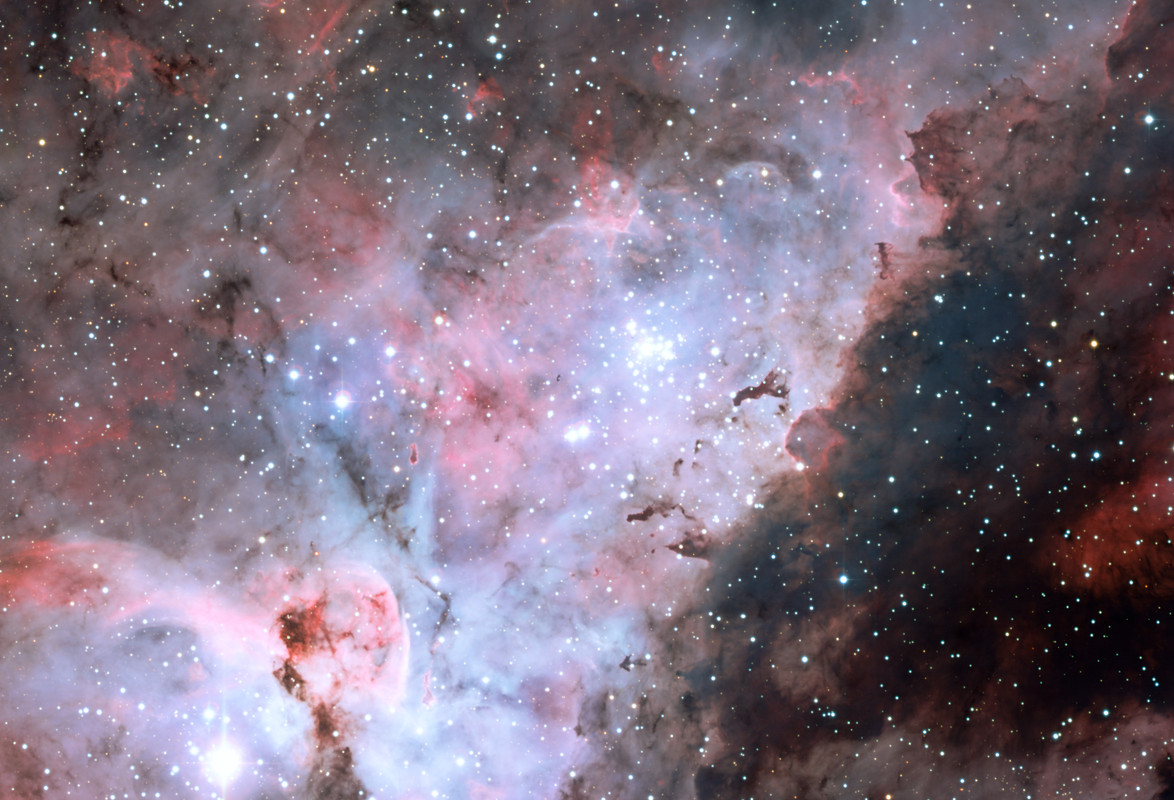
This broad image of the Carina Nebula, a region of massive star formation in the southern skies, was taken in infrared light using the HAWK-I camera on ESO’s Very Large Telescope. Many previously hidden features, scattered across a spectacular celestial landscape of gas, dust and young stars, have emerged.
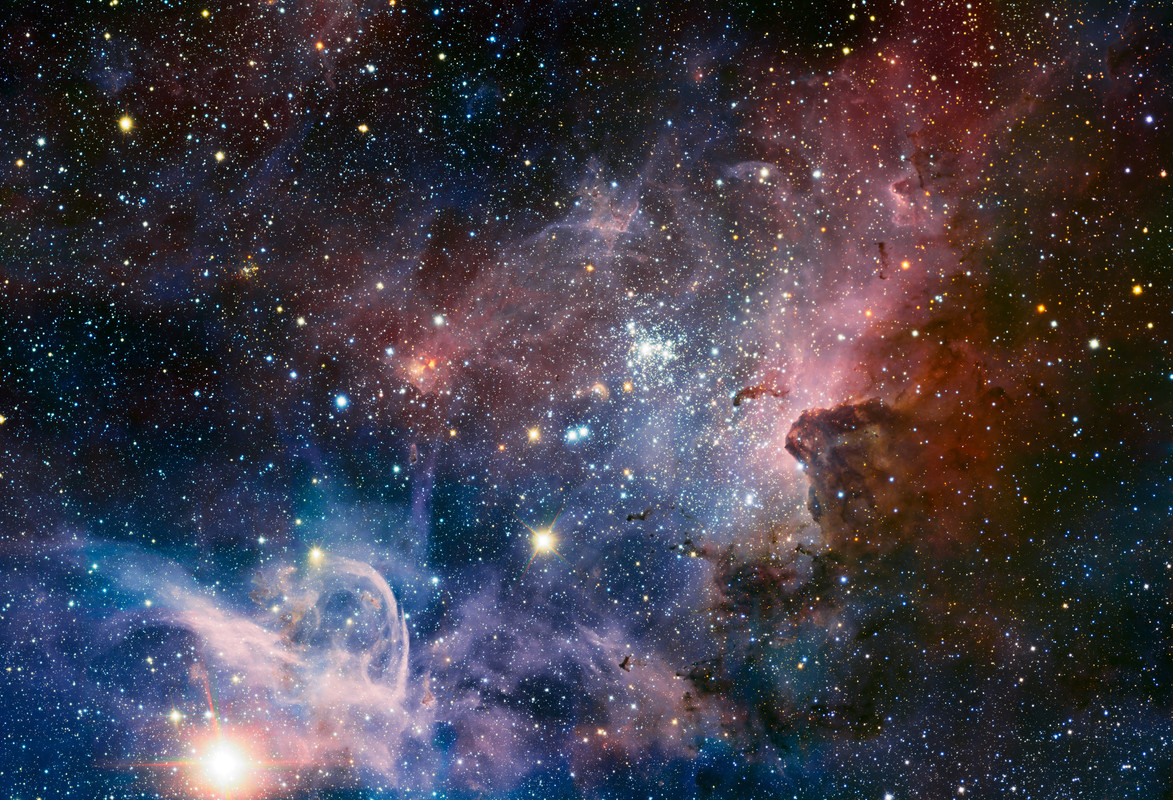
The Wide Field Imager on the MPG/ESO 2.2-meter telescope at the La Silla Observatory has imaged a region of star formation called NGC 3324. The intense radiation from several of NGC 3324's massive, blue-white stars has carved out a cavity in the surrounding gas and dust. The ultraviolet radiation from these young hot stars also cause the gas cloud to glow in rich colors.
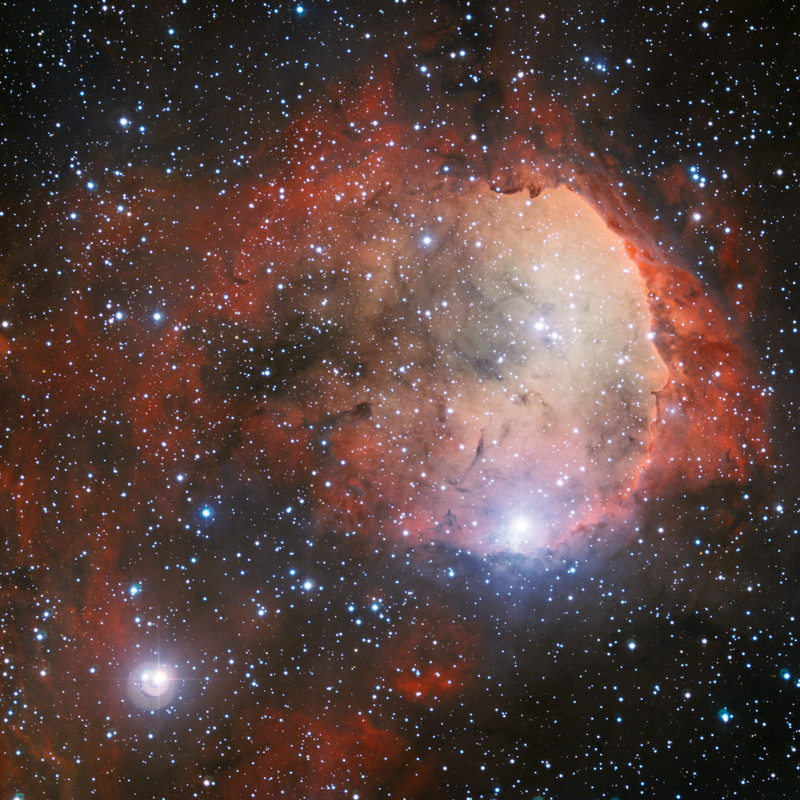

There are so many galaxies in the background its unreal...
Peculiar spiral galaxy Arp 78 is found within the boundaries of the head strong constellation Aries. Some 100 million light-years beyond the stars and nebulae of our Milky Way galaxy, the island universe is over 100,000 light-years across. Also known as NGC 772, it sports a prominent, outer spiral arm in this detailed cosmic portrait from the large Gemini North telescope near the summit of Maunakea, Hawaii, planet Earth. Tracking along sweeping dust lanes and lined with young blue star clusters, Arp 78's spiral arm is likely pumped-up by galactic-scale gravitational tidal interactions The close companion galaxy responsible is NGC 770, located off the upper right of this frame. But more distant background galaxies are clearly visible in the cosmic field of view.

The night side of Pluto spans this shadowy scene. In the stunning spacebased perspective the Sun is 4.9 billion kilometers (almost 4.5 light-hours) behind the dim and distant world. It was captured by far flung New Horizons in July of 2015 when the spacecraft was at a range of some 21,000 kilometers from Pluto, about 19 minutes after its closest approach. A denizen of the Kuiper Belt in dramatic silhouette, the image also reveals Pluto's tenuous, surprisingly complex layers of hazy atmosphere. Near the top of the frame the crescent twilight landscape includes southern areas of nitrogen ice plains now formally known as Sputnik Planitia and rugged mountains of water-ice in the Norgay Montes.

Why would the surface of Titan light up with a blinding flash? The reason: a sunglint from liquid seas. Saturn's moon Titan has numerous smooth lakes of methane that, when the angle is right, reflect sunlight as if they were mirrors. Pictured here in false-color, the robotic Cassini spacecraft that orbited Saturn from 2004 to 2017 imaged the cloud-covered Titan in 2014 in different bands of cloud-piercing infrared light. This spectacular reflection was so bright it saturated one of Cassini's infrared cameras. Although the sunglint was annoying -- it was also useful. The reflecting regions confirm that northern Titan houses a wide and complex array of seas with a geometry that indicates periods of significant evaporation. During its numerous passes of our Solar System's most mysterious moon, Cassini has revealed Titan to be a world with active weather -- including times when it rains a liquefied version of natural gas.

Color-composite image of the Carina Nebula, revealing exquisite details in the stars and dust of the region. Several well known astronomical objects can be seen in this wide field image : to the bottom left of the image is one of the most impressive binary stars in the Universe, Eta Carinae, with the famous Keyhole Nebula just adjacent to the star. The collection of very bright, young stars above and to the right of Eta Carinae is the open star cluster Trumpler 14. A second open star cluster, Collinder 228 is also seen in the image, just below Eta Carinae. The Carina Nebula also bears the NGC 3372 designation. On this image, North is up and East is to the left. The field of view is 0.55 x 0.55 degrees, covering a 72 x 72 light-year region at the distance of the nebula.

This broad image of the Carina Nebula, a region of massive star formation in the southern skies, was taken in infrared light using the HAWK-I camera on ESO’s Very Large Telescope. Many previously hidden features, scattered across a spectacular celestial landscape of gas, dust and young stars, have emerged.

The Wide Field Imager on the MPG/ESO 2.2-meter telescope at the La Silla Observatory has imaged a region of star formation called NGC 3324. The intense radiation from several of NGC 3324's massive, blue-white stars has carved out a cavity in the surrounding gas and dust. The ultraviolet radiation from these young hot stars also cause the gas cloud to glow in rich colors.

stark1
Lonesome Planet
To date there has been near five thousand exoplanets in the near space of the MW since the search began in
The late part of the last century.
The late, great Kepler Space Telescope. Retired

Kepler 1625b in Cygnus is a Jovian like planet with a possible Neptune size exo-moon, Kepler 1625b-1.

The small secondary dip in the light profile suggests a possible Neptune size exomoon orbiting the exoplanet.
The binary orbiting an evolved yellow G star.


If confirmed, it will be the first exo-moon of record.
The late part of the last century.
The late, great Kepler Space Telescope. Retired

Kepler 1625b in Cygnus is a Jovian like planet with a possible Neptune size exo-moon, Kepler 1625b-1.

The small secondary dip in the light profile suggests a possible Neptune size exomoon orbiting the exoplanet.
The binary orbiting an evolved yellow G star.


If confirmed, it will be the first exo-moon of record.
Last edited:
CrazyDiamond
HAL is a StarChild
Some 60 million light-years away in the southerly constellation Corvus, two large galaxies are colliding. Stars in the two galaxies, cataloged as NGC 4038 and NGC 4039, very rarely collide in the course of the ponderous cataclysm that lasts for hundreds of millions of years. But the galaxies' large clouds of molecular gas and dust often do, triggering furious episodes of star formation near the center of the cosmic wreckage. Spanning over 500 thousand light-years, this stunning view also reveals new star clusters and matter flung far from the scene of the accident by gravitational tidal forces. The remarkably sharp ground-based image, an accumulation of 88 hours of exposure captured during 2012-2021, follows the faint tidal tails and distant background galaxies in the field of view. The suggestive overall visual appearance of the extended arcing structures gives the galaxy pair, also known as Arp 244, its popular name - The Antennae.
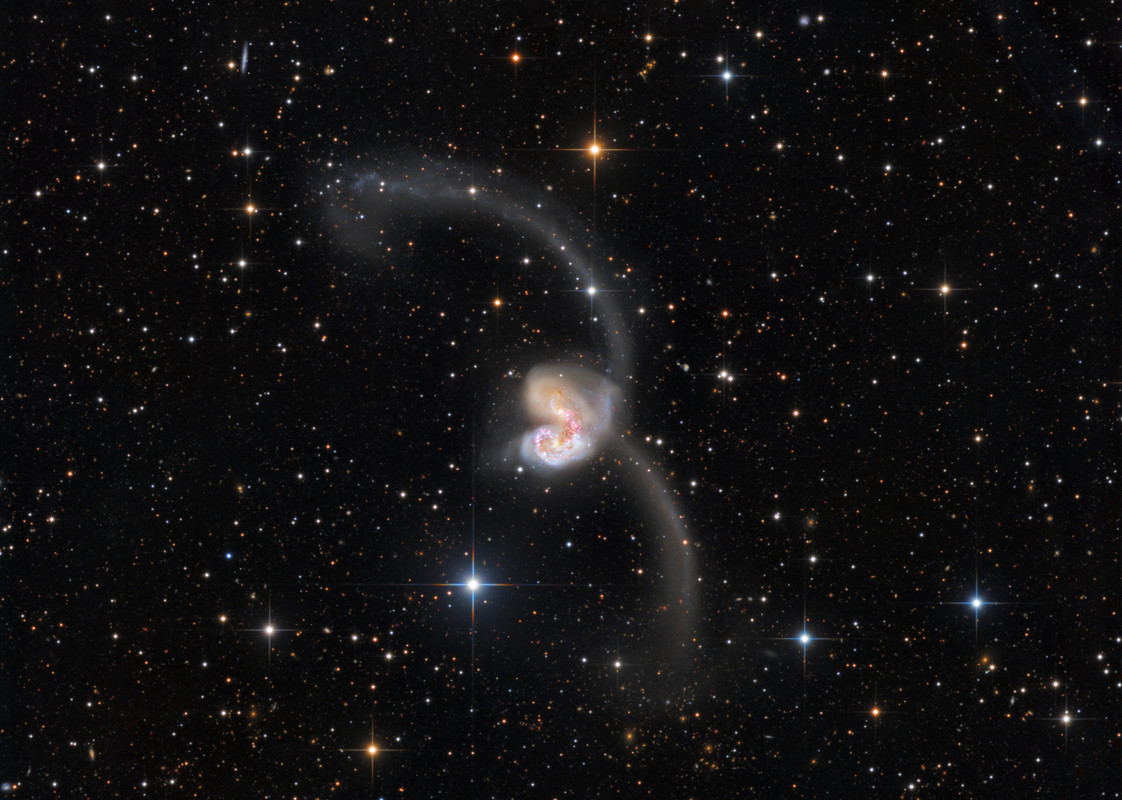
The VLT Survey Telescope (VST) has captured in sharp detail the beauty of the nearby spiral galaxy NGC 253. This new portrait is probably the best wide-field view of this object and its surroundings ever taken. It demonstrates that the VST, the newest telescope at ESO's Paranal Observatory, provides broad views of the sky while also offering impressive image quality. Luminous regions of ongoing star formation are spread throughout NGC 253, which is pumping out new stars at a furious pace.
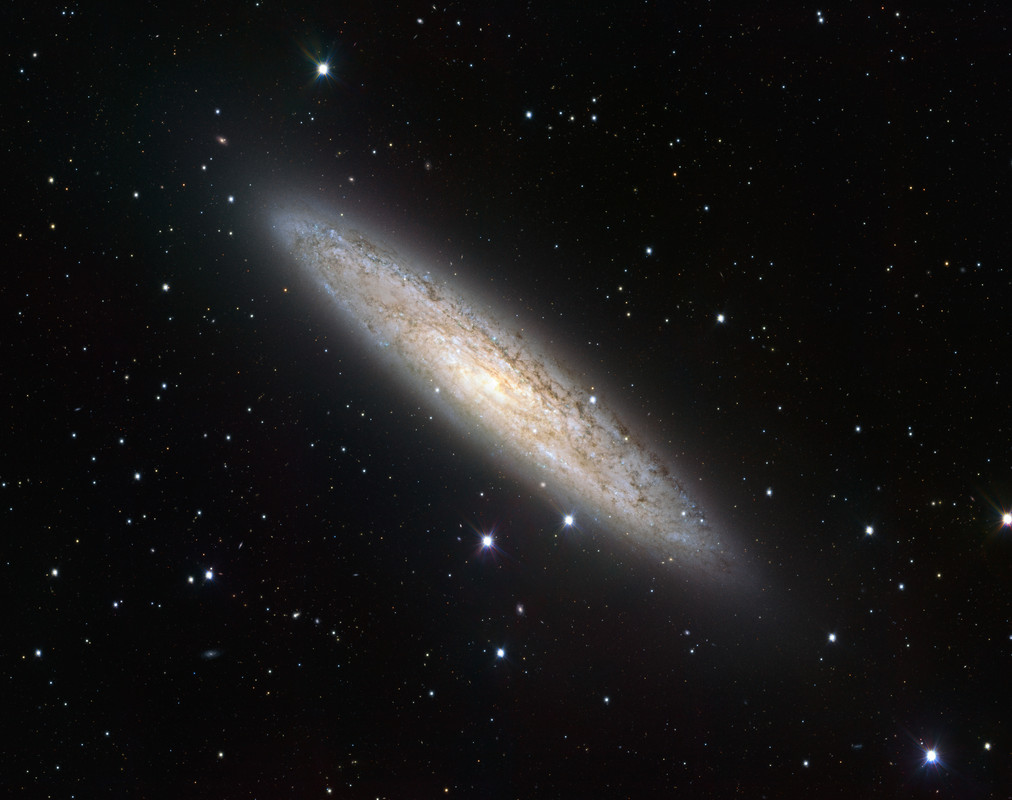
This view shows part of the stellar nursery called the Tarantula Nebula in the Large Magellanic Cloud, a small neighbor of the Milky Way. At the center lies the brilliant star VFTS 102 This view includes both visible-light and infrared images from the Wide Field Imager at the MPG/ESO 2.2-metre telescope at La Silla and the 4.1-metre infrared VISTA telescope at Paranal. VFTS 102 is the most rapidly rotating star ever found.
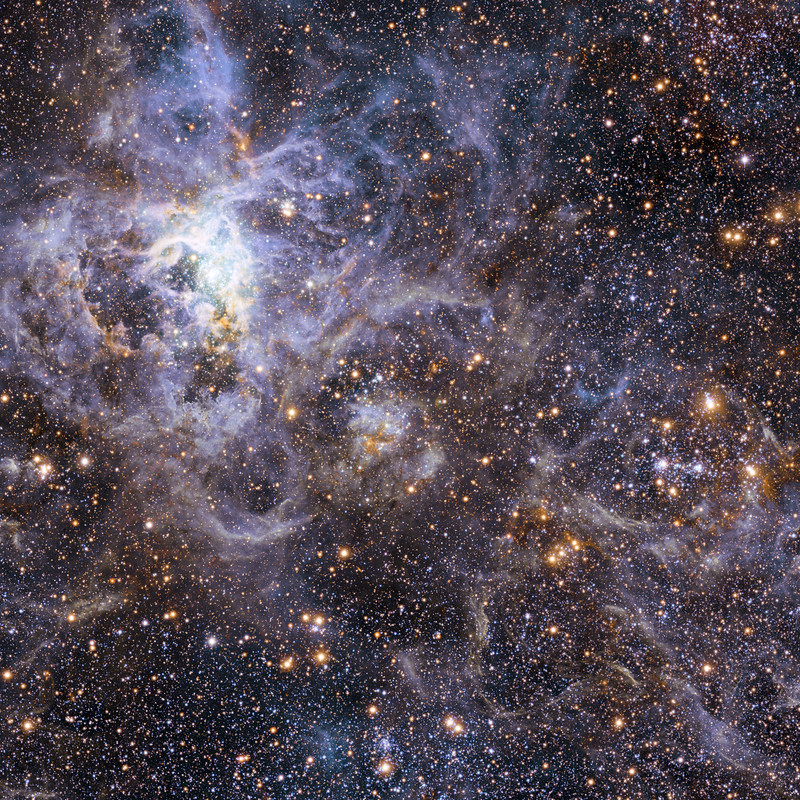
Observations made with the APEX telescope in submillimeter-wavelength light at a wavelength of 870 µm reveal the cold dusty clouds from which stars form in the Carina Nebula. This site of violent star formation, which plays host to some of the highest-mass stars in our galaxy, is an ideal arena in which to study the interactions between these young stars and their parent molecular clouds.
The APEX observations, made with its LABOCA camera, are shown here in orange tones, combined with a visible light image from the Curtis Schmidt telescope at the Cerro Tololo Interamerican Observatory. The result is a dramatic, wide-field picture that provides a spectacular view of Carina’s star formation sites. The nebula contains stars equivalent to over 25 000 Suns, and the total mass of gas and dust clouds is that of about 140 000 Suns.
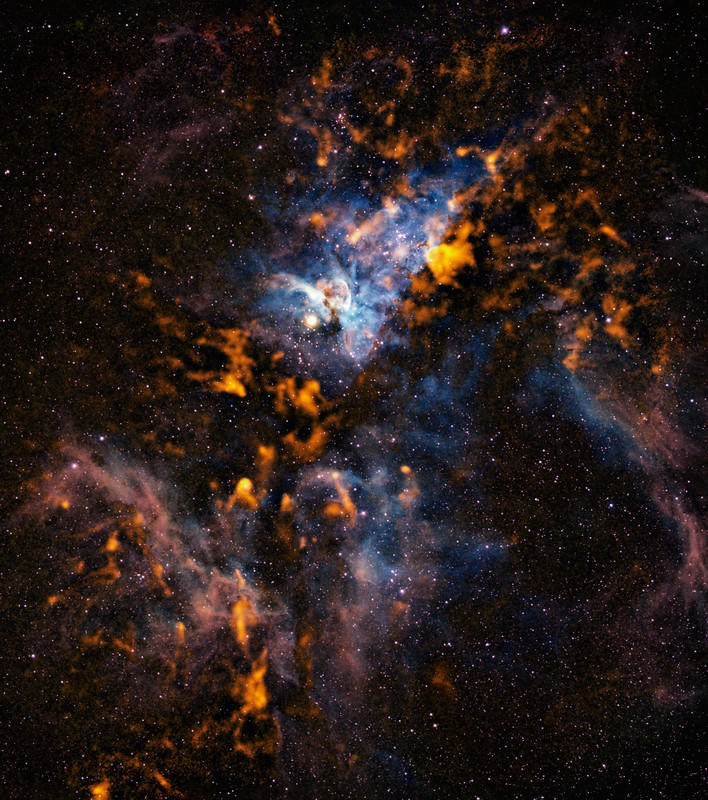
This image is a color composite made from exposures from the Digitized Sky Survey 2 (DSS2) of the Eta Carinae Nebula. The field of view is approximately 4.7 x 4.9 degrees.
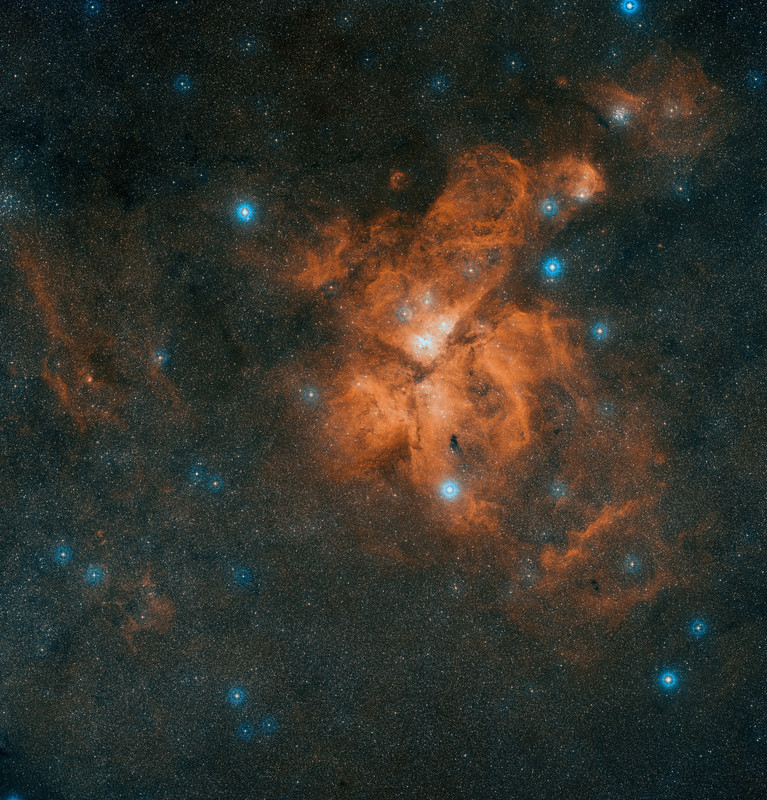
This last image has a dimension of 10000x5399
On the upper right, dressed in blue, is the Pleiades. Also known as the Seven Sisters and M45, the Pleiades is one of the brightest and most easily visible open clusters on the sky. The Pleiades contains over 3,000 stars, is about 400 light years away, and only 13 light years across. Surrounding the stars is a spectacular blue reflection nebula made of fine dust. A common legend is that one of the brighter stars faded since the cluster was named. On the lower left, shining in red, is the California Nebula. Named for its shape, the California Nebula is much dimmer and hence harder to see than the Pleiades. Also known as NGC 1499, this mass of red glowing hydrogen gas is about 1,500 light years away. Although about 25 full moons could fit between them, the featured wide angle, deep field image composite has captured them both. A careful inspection of the deep image will also reveal the star forming region IC 348 and the molecular cloud LBN 777 (the Baby Eagle Nebula).
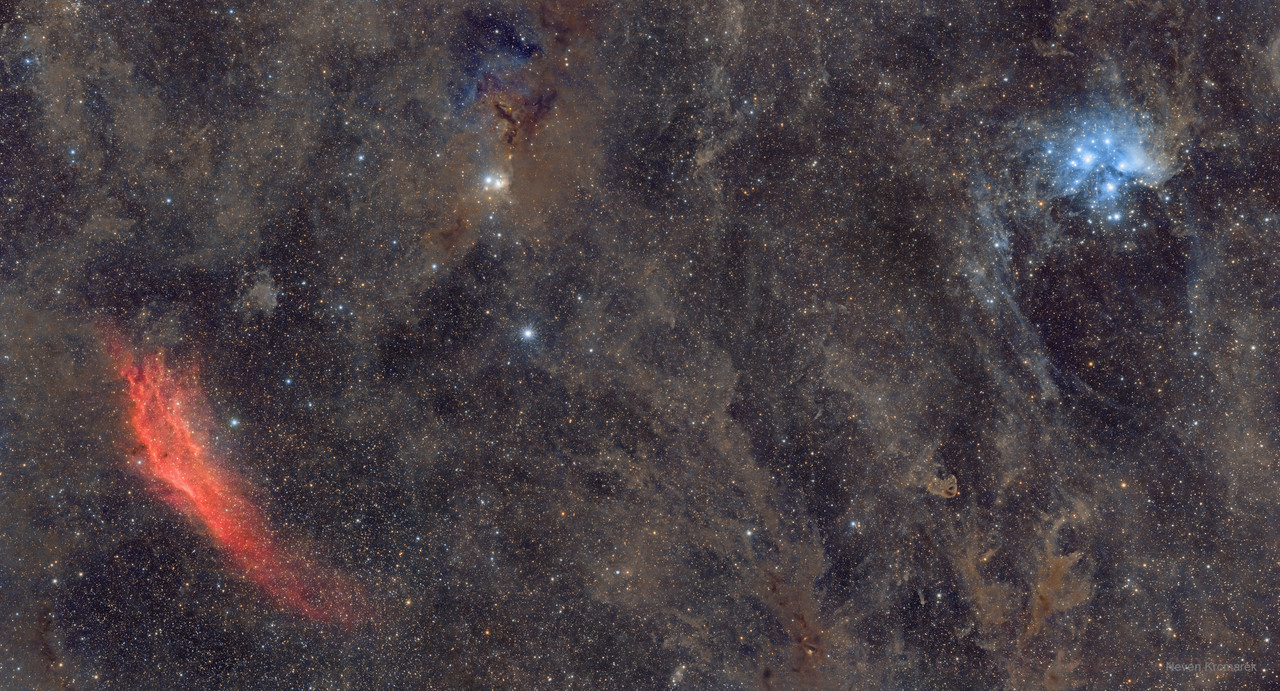

The VLT Survey Telescope (VST) has captured in sharp detail the beauty of the nearby spiral galaxy NGC 253. This new portrait is probably the best wide-field view of this object and its surroundings ever taken. It demonstrates that the VST, the newest telescope at ESO's Paranal Observatory, provides broad views of the sky while also offering impressive image quality. Luminous regions of ongoing star formation are spread throughout NGC 253, which is pumping out new stars at a furious pace.

This view shows part of the stellar nursery called the Tarantula Nebula in the Large Magellanic Cloud, a small neighbor of the Milky Way. At the center lies the brilliant star VFTS 102 This view includes both visible-light and infrared images from the Wide Field Imager at the MPG/ESO 2.2-metre telescope at La Silla and the 4.1-metre infrared VISTA telescope at Paranal. VFTS 102 is the most rapidly rotating star ever found.

Observations made with the APEX telescope in submillimeter-wavelength light at a wavelength of 870 µm reveal the cold dusty clouds from which stars form in the Carina Nebula. This site of violent star formation, which plays host to some of the highest-mass stars in our galaxy, is an ideal arena in which to study the interactions between these young stars and their parent molecular clouds.
The APEX observations, made with its LABOCA camera, are shown here in orange tones, combined with a visible light image from the Curtis Schmidt telescope at the Cerro Tololo Interamerican Observatory. The result is a dramatic, wide-field picture that provides a spectacular view of Carina’s star formation sites. The nebula contains stars equivalent to over 25 000 Suns, and the total mass of gas and dust clouds is that of about 140 000 Suns.

This image is a color composite made from exposures from the Digitized Sky Survey 2 (DSS2) of the Eta Carinae Nebula. The field of view is approximately 4.7 x 4.9 degrees.

This last image has a dimension of 10000x5399
On the upper right, dressed in blue, is the Pleiades. Also known as the Seven Sisters and M45, the Pleiades is one of the brightest and most easily visible open clusters on the sky. The Pleiades contains over 3,000 stars, is about 400 light years away, and only 13 light years across. Surrounding the stars is a spectacular blue reflection nebula made of fine dust. A common legend is that one of the brighter stars faded since the cluster was named. On the lower left, shining in red, is the California Nebula. Named for its shape, the California Nebula is much dimmer and hence harder to see than the Pleiades. Also known as NGC 1499, this mass of red glowing hydrogen gas is about 1,500 light years away. Although about 25 full moons could fit between them, the featured wide angle, deep field image composite has captured them both. A careful inspection of the deep image will also reveal the star forming region IC 348 and the molecular cloud LBN 777 (the Baby Eagle Nebula).







